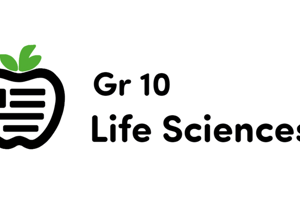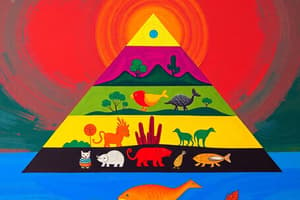Podcast
Questions and Answers
What percentage of the net productivity of one trophic level is passed to the next trophic level?
What percentage of the net productivity of one trophic level is passed to the next trophic level?
10%
What is one reason for the inefficiency in energy transfer between trophic levels?
What is one reason for the inefficiency in energy transfer between trophic levels?
Some energy is used in cellular respiration rather than stored as biomass.
How are trophic levels calculated for an organism?
How are trophic levels calculated for an organism?
As a mean of the trophic levels of food items in a species' diet, weighted by quantity.
What do higher trophic levels typically require more of to sustain them?
What do higher trophic levels typically require more of to sustain them?
What does Human Trophic Levels (HTL) reflect?
What does Human Trophic Levels (HTL) reflect?
How is trophic transfer efficiency (TTE) usually calculated?
How is trophic transfer efficiency (TTE) usually calculated?
What are some challenges in estimating Trophic Transfer Efficiency (TTE) in marine environments?
What are some challenges in estimating Trophic Transfer Efficiency (TTE) in marine environments?
What is the range of trophic transfer efficiency (TTE) rates seen in ecosystems?
What is the range of trophic transfer efficiency (TTE) rates seen in ecosystems?
Why does energy become increasingly scarce as it moves up trophic levels?
Why does energy become increasingly scarce as it moves up trophic levels?
What are some factors contributing to the inefficiency in energy transfer between trophic levels?
What are some factors contributing to the inefficiency in energy transfer between trophic levels?
Flashcards are hidden until you start studying
Study Notes
Energy Transfer in Trophic Levels
Energy flows through ecosystems, moving from one trophic level to the next via consumption. This transfer is inefficient, with only about 10% of the net productivity of one trophic level being passed to the next. As energy moves up trophic levels, it becomes increasingly scarce due to the second law of thermodynamics and the various energy losses during transfer.
The transfer efficiency varies between trophic levels, with some ecosystems showing lower rates (around 3–20%). This inefficiency results from factors such as not all organisms at a lower trophic level being eaten, molecules being lost because they're not digestible, and some energy being used in cellular respiration rather than stored as biomass.
Trophic levels represent an organism's position within a food web. They are calculated as a mean of the trophic levels of food items in a species' diet, weighted by quantity. Higher trophic levels typically require more primary production to sustain them. Human trophic levels (HTL) reflect human diets, and they can be used to monitor human impact on ecosystems.
Trophic transfer efficiency (TTE) is usually calculated as the ratio of production rates between two consecutive trophic levels. In marine environments, TTE has been estimated for a few freshwater systems, but obtaining reliable estimates is challenging due to the high data requirements. Trophic level efficiency (TLE) measures how efficiently each trophic level uses and incorporates the energy from its food.
Efficiency decreases as energy moves up trophic levels. For instance, in the Lake Ontario ecosystem food web, there were only three energy transfers between primary producers and the tertiary consumer, Chinook salmon. In general, food chains can usually sustain no more than six energy transfers before all the energy is used up.
Understanding energy transfer in trophic levels is crucial for evaluating ecosystem health, predicting the impacts of human activities, and developing sustainable management strategies.
Studying That Suits You
Use AI to generate personalized quizzes and flashcards to suit your learning preferences.





